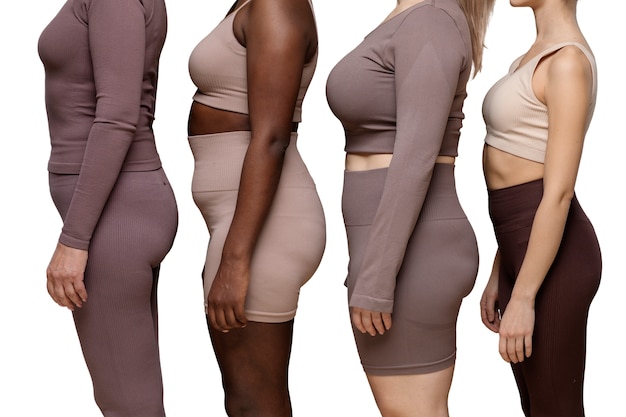Body Image After Weight Loss
You lost the weight. The scale moved. Clothes are looser. Friends notice. Yet inside, your reflection still looks too heavy, or you hesitate to celebrate the changes. You avoid buying new clothes, you fear regaining, and you struggle to accept your new body.
This is a real phenomenon! In this post, we’ll explore why losing weight doesn’t always heal body image, how this relates to body dysmorphia and “phantom fat,” and steps you can take (with compassion) to support your ongoing body-image healing.
The Disconnect: What the Research Shows
Phantom Fat, Ghost Fat, and Lingering Perception
Even after extraordinary physical change, many people continue to perceive themselves as larger than they are. This is often called “phantom fat,” “ghost fat,” or “vestigial body image.” (My Vanderbilt Health)
- In one review, individuals who had formerly been overweight still showed poorer self-image, higher “overweight preoccupation,” and dysfunctional appearance investment compared to those who had never been overweight, even after weight loss. (PubMed)
- In bariatric surgery cases, despite significant weight reduction, some participants continued to report distortions in how they perceived their body dimensions over time. (PubMed)
- The phenomenon may partly reflect how quickly the mind’s “map” of your body updates (or doesn’t). The body may change faster than the brain’s visual and sensory expectations can adjust. (Medscape)
Legacy of Stigma and Internalized Beliefs
Weight loss doesn’t automatically erase years (or decades) of cultural, interpersonal, and internal messaging around bodies, size, and worth. People who were overweight often carry a “shadow of stigma” that continues to influence how they see themselves. (PubMed)
One analysis found that even if someone loses weight, the psychosocial advantages of never having been overweight remain: body satisfaction, social confidence, and lower preoccupation with appearance can persist in those who weren’t stigmatized earlier in life. (PubMed)
Rapid Change & Sensory Mismatch
When weight is lost quickly (via surgery, medications, or aggressive approaches) the sensory mismatch is larger. The body feels new, but your internal sensations, proprioception, and habitual movement patterns are still tuned to the “old” body. That gap can drive dissonance in how you see or feel yourself. (Medscape)
Why Body Image Is Hard to “Fix”
Understanding this helps explain why many feel stuck:
- Mirror and visual feedback often feel disconnected. Compliments or seeing smaller clothes may not “feel real.”
- You may carry fear of “relapse.” The anxiety that weight will return can keep your internal system in hypervigilance, never fully relaxing into the change.
- You might still cling to “old you” identity or safety. The heavier former body sometimes feels familiar, even comforting, and the new one can feel exposed.
- Body image healing is separate from weight change. Just because your physical body shifts, the internal narrative, habits, and emotional wounds remain unless they’re addressed.
A HAES-Aligned, Weight-Inclusive Path Forward
Healing body image doesn’t require more dieting or forcing acceptance. Instead, it’s a compassionate, process-oriented journey. Here are strategies rooted in weight-inclusive, HAES-aligned principles:
-
Challenge the Narrative, Not Your Body
Journal or list internal beliefs you hold (e.g. “I still look fat,” “I can’t trust my reflection”). Question: Are they true? Who told you? Replace with kinder, curiosity-based alternatives.
-
Mirror Exposure with Neutrality
Spend a minute or two each day simply observing your body in a mirror—hands, torso, legs—without judgment, critique, or change-making. Allow familiarity to grow.
-
Focus on Function, Not Appearance
Celebrate what your body does! Examples might include walking farther, getting stronger, sleeping better, and reducing pain. This shift aligns with HAES’s emphasis on health behaviors over weight.
-
Try Gentle Wardrobe Integration
When ready, purchase one item in your current size, even if it feels “too snug” at first. Wear it on short errands. Let your body adjust, and your mind grow accustomed over time.
-
Use Compassionate Language & Self-Talk
When harsh thoughts arise, talk to yourself as you would a friend. “My body has carried me so far.” “I deserve kindness every day.” “I am more than a shape.”
-
Seek Trauma- and Body-Image-Aware Support
Working with a therapist who understands body dysmorphia, internalized stigma, or eating/body image challenges can provide tools and space to heal. Sometimes cognitive behavioral therapy (CBT), mirror work, or somatic therapy helps rebuild alignment between internal and external perception.
What to Keep in Mind
- The process is nonlinear. Some days will feel closer to acceptance; others feel like stepping back.
- You don’t have to “love” your body today, but you can practice showing it respect, safety, and curiosity.
- You are not obligated to maintain any size, and your worth is not tied to appearance or numbers.
- Healing has no fixed endpoint; it’s about building new relationships with your body, mind, and identity over time.
Final Thoughts
“Why Body Image Doesn’t Always Improve After Weight Loss” is not a flaw; it’s part of the deeper story your body and mind are still writing. Losing weight is one change, transforming how you see, feel, and live in your body is another. The gap between your physical progress and your internal perception is real, and it deserves gentle attention, not condemnation.
If you find yourself delaying buying new clothes, avoiding mirrors, or fearing relapse, know: these are valid experiences, not moral failures. Your body deserves patience. Your mind deserves compassion. And with time, practice, and support, your internal narrative can catch up.



